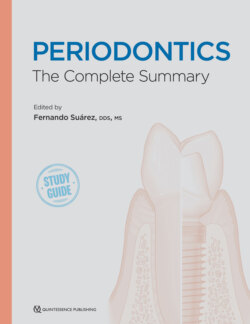Читать книгу Periodontics - Fernando Suarez - Страница 29
На сайте Литреса книга снята с продажи.
BLEEDING ON PROBING
ОглавлениеBOP is another important parameter to record during periodontal examination, and it indicates evidence of gingival inflammation. A prospective study by Lang and colleagues evaluated the prognostic value of sites with BOP and the risk for periodontal breakdown of at least 2 mm of attachment loss during periodontal maintenance therapy.18 The results showed that only a 30% probability of future attachment loss may be predicted for sites repeatedly positive for BOP (Table 2-2).18 Further calculations confirmed that frequent BOP for prediction of future attachment loss yields a specificity of 88%, and the continuous absence of BOP has a positive predictive value of 98%.19 Therefore, it is of paramount importance to understand that BOP alone does not represent a good positive predictor for disease progression7; instead, studies have shown that absence of BOP is a more reliable parameter to indicate periodontal stability.19 BOP is also sensitive to the forces applied with the probe2,19; therefore, Lang et al suggested a probing force of 25 g (0.25 N) when recording BOP, as heavier pressures (> 25 g) might traumatize the gingival tissue and provoke bleeding.19 In conclusion, the presence of BOP has low sensitivity and high specificity with respect to the development of additional attachment loss. For clinicians to monitor patients’ periodontal stability over time in daily practice, the absence of BOP at 25 g is a reliable indicator for periodontal stability with a negative predictive value of 98%.7,18,19
TABLE 2-2 Positive predictive values for loss of attachment of ≥ 2 mm in 2 years in sites that bled on probing 0, 1, 2, 3, or 4 times out of 4 maintenance visits18
| BOP incidence | Sites with loss of attachment > 2 mm |
| 4/4 | 30% |
| 3/4 | 14% |
| 2/4 | 6% |
| 1/4 | 3% |
| 0/4 | 1.5% |
